Corel
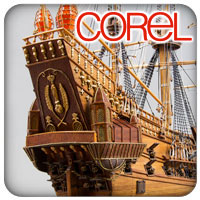 |
Corel maakt sinds 1971 modellen van historische en moderne schepen van hoge kwaliteit. Er wordt gebruik gemaakt van de beste materialen. Bijna geen plastic, hout van goede kwaliteit in verschillende tinten, gegoten en vergulde metalen decoraties, foto-geëtste onderdelen in messing of koper, en alles is voorzien voor een gemakkelijke montage van het model. Elke modelbouwer zal het “volledig voorgesneden” systeem waarderen. Waar mogelijk zijn alle onderdelen voorgesneden en klaar voor montage. |
| Naam | Omschrijving | Afbeelding |
|---|---|---|
| Mirage | The MIRAGE was a first rate flagship armed with 84 guns, in service with the French Navy during the reign of Louis XIV. Thanks to our efforts and experience we can offer our usual “ready-cut” components which are so carefully and perfectly finished that the firing hatches can be opened and closed. This is an absolute novelty in this field worthy of specific consideration, bearing in mind the difficulties encountered in the past with less detailed kits. The box contains all the materials prepared and ready for assembly, the relative accessories, the instructions plus a detailed diagram and an elegant base to support the finished model. Details :Scale 1:75 Height 790 mm Length. 870 mm | 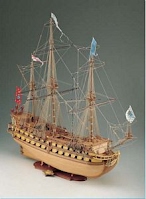 |
| Wasa | 17th century Swedish ship The WASA, a royal Swedish vessel with 64 guns sank in the waters around Stockholm on the day it was launched (10 August 1628) as the result of a violent gust of wind. The ship settled in 35 m of water. Construction on the vessel started in 1625, under the direction of the Dutch architect Henrik Hybertsson. While some guns and a few other objects had been recovered earlier, it was only possible to bring the ship to the surface in 1956. Partially rebuilt and restored, the WASA was installed in the Wasa Museum in Stockholm in 1958.Our reproduction of the WASA is based on the excellent graphic reproductions published by the Board of the Museum Details :Scale 1:75 Height 700 mm Length. 890 mm |  |
| Reale de France | 17th century galley The origins of the galley, a typical warship characterised by a very streamlined shape, can be traced back to the Mediterranean ships of classical antiquity. The first examples of the galley date back to the end of the 12th century Successive modifications led to the special lines of the 16th century, its period of greatest espansion and utilisation. Its original function as a vessel of war having been abandoned, the last galleys survived until the second half of the 18th century as status symbols. reproduction of a sumptuous galley of the time of Louis XIV. The original documentation used for the reconstruction is kept in a famous French museum. Details :Scale 1:60 Height 670 mm Length.1060 mm | 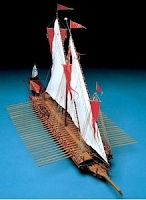 |
| Paranza | Italian boat An Italian boat which is typical of the central Adriatic and was widely used at one time in the area between the mouth of the Savio and the Gargano. The reconstruction is based on measurements and surveys from life and ample photographic documentation from the Forties to the Sixties. kit contains :pre cut keel and bulk heads ,along with woods and fittings to complete the model Details :Scale 1:25 Height 510 mm Length. 340 mm | 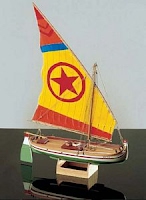 |
| Sirene | French frigate of the middle of the 18th century This 30 gun French frigate is famous because of its designer, the well-known naval architect Fredrik Chapman. In addition to the drawings, all the calculations relating to the construction and the hydrodynamic resistance of the vessel are provided in Chapman’s Architectura Navalis Mercatoria, published in Stockholm in 1768. Thanks to the fact that everything is cut the preparation of the components and the choice of woods even those of you who are not experts can build a faithful reconstruction of this beautiful ship with our model, which is based on Chapman’s plans. Details :Scale 1:75 Height 720 mm Length. 845 mm | 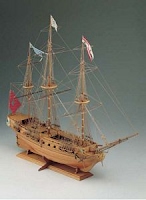 |
| Prins Willem | 17th century Dutch vessel The PRINS WILLEM was probably the largest square stern ship of the fleet of the Dutch East India Company. Fitted out at Middleburg in 1649-1650 the Prins Willem was subsequently modified for use as a warship. In addition to demolishing the forecastle and the stern bulkhead, 6 firing ports were added three on each side. For a brief period, the PrinsWillem was the flagship of the famous Admiral Witte de Witt. Returned later to the Company it once again traded with the Indies between 1653 and 1660. Our model is a detailed and faithful reconstruction of the ship fitted out by the Dutch East India Company for commercial traffic. Details :Scale 1:100 Height 580 mm Length. 735 mm | 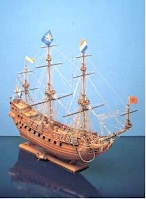 |
| Ranger | American Cutter, 1823 The RANGER was one of the typical American cutters built in the first half of the 19th century and basically used for surveillance and castguard duties. It was armed with a large carronade installed in the centre of the deck that rotated on a circular guideway permitting rapid fire from both sides of the hull with a single weapon. Note the particular elegant line of the RANGER, emphasised by the depth of the keel at the stern. Given the generic nature of the tasks it performed, no significant events are known in which this type of cutter was involved. . Details :Scale 1:50 Height 390 mm Length. 465 mm | 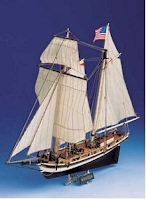 |
| Mistique | Scale of this ship is 1:50. Length is 32" , Height 32" She is a double plank-on-bulkhead construction with pre-cut wooden parts made of beech, boxwood, walnut and mahogany. Fittings made in walnut, copper and brass and has over 50 gilded metal ornaments and moldings . This is a highy detailed model.Comes with Six sheets of plans and detailed instruction book guide you through every phase of construction. |  |
| Scotland | Baltic Ketch-Yacht The Scotland, a ship dating back to the end of the eighteenth century, belongs to the category of the Baltic Ketch Yachts and was chiefly used for the transport of goods and passengers, also on rivers and the most important lakes. While being traditionally a work boat so-called because it was mainly used for commercial purpose. The Scotland can be distinguished from the multitude of different kinds of relatively small boats, that is to say, those between 50 and 60 feet long, by its impressive sails and the pleasing and soft lines of the hull. Even Chapman himself, in a note dated 1775, mentioned this type of ship because of the purposes for which it was used but he called it “Galeas, a Baltic Vessel”. Details :Scale 1:64 Height 415 mm Length. 430 mm |  |
| Sloup | Breton boat The sloup coquiller was typical of the area of Brest in the Department of Finisterre in Brittany, being used for catching shell-fish. The graphic plan is based on a large range of photographs dating from 1912 to the early Eighties. kit contains :pre cut keel and bulk heads ,along with woods and fittings to complete the model Details :Scale 1:25 Height 405 mm Length. 320 mm |  |
| Touonnaise | French schooner, 1823 Launched in Toulon on 13 August 1823 the TOULONNAISE served in the Spanish War under Captain Joursin, was stationed at Barcelona and then sailed to Cadiz where it took part in the bombardment of the port. In 1832 it was completely overhauled at Brest and parts of the internal and external gunwales, the waterways and the planking of the bridge were replaced and the entire poop deck superstructure was redone. Our model is based on drawings taken from a large size model in a famous French museum. The high level of pre-preparation of the components and the numerous diagrams contained in the box make this model very easy to construct, expressly designed for beginners. Details :Scale 1:75 Height 450 mm Length. 655 mm | 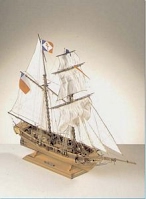 |
| Wappen von Hamburg | 17th century Brandenburg ship A 17th century vessel armed with 58 guns. This model, unique of its kind, has been designed to offer an excellent model in terms of quality and the faithfulness of the reproduction.All the pieces in precious woods are supplied ready cut and shaped. The box includes all the small items for the finishing and a detailed drawing in seven plates plus an instruction book containing a large number Details :Scale 1:40 Height 910 mm Length. 1100 mm |  |
| Wasa Gun Enplacment | Armed section Vertical section of the left wall of the WASA with part of the deck and the underlying gun deck.Special attention has been dedicated to the cannon and the gun mounting and to the reconstruction Details :Scale 1:24 Height 180 mm Length. 215 mm | 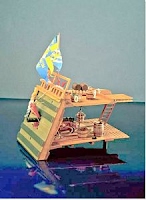 |
| Yacht d'Oro | 17th century armed yacht from Brandenburg This vessel, also known as the New Yacht or Great Yacht, was built in Kolberg in 1678-1679 by the shipbuilder Peckelherius. Details :Scale 1:50 Height 520 mm Length. 580 mm | 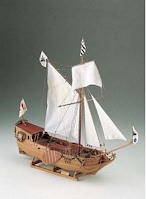 |
| Berlin | 17th century Brandenburg frigate The BERLIN was one of the first charter frigates put at the disposition of Frederic William by the Brandenburg Navy. Built in Zeeland in 1674, the vessel formed part of the Brandenburg fleet until 1688. The model reproduces the vessel down to the tiniest details. The ornaments of the poop-deck in gilded metal are particularly fine and the frame and planking of the hull are in precious wood. The box contains all the components already cut plus a wide range of accessories. The instructions include 4 large life-size plates, and a full instruction book accompanied by a large number of diagrams and some photos of the model. Details :Scale 1:40 Height 690 mm Length. 830 mm | 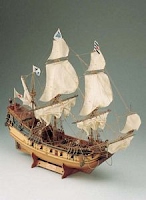 |
| Half Moon | Early 17th century Dutch galleon In 1609, the English captain, Henry Hudson aboard the HALF MOON was trying to find a North-West passage to Asia when he discovered a bay into which a river 500 km long drained. After sailing up the river, Hudson took possession in the name of the Dutch government baptising it the North or Maurice River in honour of the Prince of Nassau. Our box contains a faithful reproduction of the original ship which is easy to assemble thanks to our new technical assembly criteria the excellent quality of our materials the clarity of the drawings which are easy to read. The complete prefabrication of the components (excluding the synthetic materials). Details :Scale 1:50 Height 525 mm Length. 520 mm | 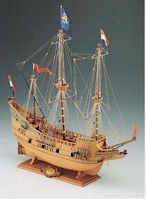 |
| Shenandoah | American cutter of 1864 The term Custom Cutter was used to describe ships used for rapid transport of precious or perishable goods along the Atlantic coast and to support or resupply larger vessels. Details :Scale 1:50 Height 590 mm Length. 700 mm | 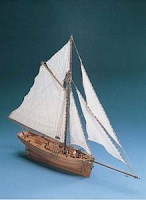 |
| Anphion | Swedish yacht Designed and built as a fast vessel for the use of king Gustav III of Sweden It was also used in naval battles such as the victorious Battle of Svenskund against the Russians. Launched in 1778, it was built to a design of Fredrik Chapman in the Djurgarden shipyard in Stockholm. Chapman was the first naval architect to codify the design of the hull on the basis of precise mathematical ratios, rather than relying exclusively on empirical methods common at that time. The ship was schooner-rigged and this, together with the tapered line of the hull, gave it exceptional sailing qualities. Our model is based on original documents of the period and shows the ship as it looked in 1790. Details :Scale 1:40 Height 620 mm Length. 785 mm | 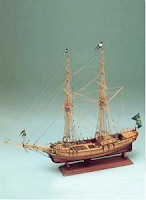 |
| International Class Monotype | International class monotype The 5,5 m S.I. (International Class) is one of the most common fixed keel regatta yachts included in the “formula” International Classes. The 5,5 m yacht was added to the existing 6,8 and 12 m yachts in 1949 when a special 5,5 m class was established. kit contains :pre cut keel and bulk heads ,along with woods and fittings to complete the model Details :Scale 1:25 Height 500 mm Length. 390 mm | 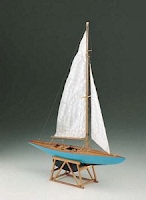 |
| Couronne | French ship of the line, 1636 The first great ship to be completely designed and constructed by the French. On the orders of Cardinal Richelieu, the work was entrusted to the famous master craftsman Charles Morieur of Dieppe. The ship was completed in 1636 in the La Roche Bernard shipyard and was one of the most imposing vessels of that time. Special attention was paid to the sculptural decoration of the ship which was carried out by sculptors in wood. Using our tried and tested system of cross sections and double planking which characterises most of our preparation of the components this model is outstanding because of the quality and variety of the woods which have been used. Details :Scale 1:100 Height 605 mm Length. 850 mm |  |
| Al Bahran | The model reproduces a typical dhow used in the waters surrounding the Arabian peninsula for fishing and coastal trading. During the colonial occupation, the Italian Navy armed them with 37 mm guns. Details :Scale 1:50 Height 465 mm Length. 575 mm |  |
| Bellona | 74-gun ships of the British Navy (1780) The H.M.S. (His Majesty’s Ship)BELLONA was one of the most famous 74-gun ships of the British Navy. The BELLONA, launched on 19 February 1760, sailed to join the battlefleet which was then blockading Brest. On 30 December 1780 the BELLONA took part in the capture of the 44-gun Dutch ship Princess Caroline; then she cruised off Gibraltar in the North Sea and the West Indies. She was employed in the blockade of Cadiz; then, the BELLONA was at Jamaica, at Portsmouth and at Barbados. Although more than 50 years from her launch were passed, the BELLONA served in the Navy until February 1814. Details :Scale 1:100 Height 615 mm Length. 770 mm | 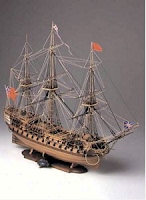 |
| Corsaro II | Training ship of the Italian Navy The famous high-sea regatta yacht Class I R.O.R.C., designed by Stephens and Sparkman. Yawl-rigged. The CORSARO II became an Italian Navy training ship for officers in January 1961. The CORSARO II has taken part in numerous international cruises and regattas in the Atlantic and Pacific obtaining brilliant results including: 1st place in the Honolulu-Kanal regatta, 1961; 1st place in the Torbay- Rotterdam race, 1962; 1st place in the Lisbon-Bermuda race, 1964. The box contains Lime and walnut wood to plank the hull and deck along with a wide variety of accessories,detailed construction plans and an instruction book that all go to produce a stunning looking model . Details :Scale 1:24 Height 940 mm Length. 810 mm | 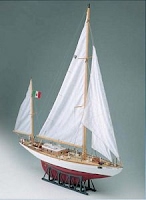 |
| Dolphyn | Dutch privateer ketch, 1750 An attractive ketch launched in 1750 armed with 10 cannon and 6 culverins. This elegant box contains everything needed to assemble the model: different kinds of precious woods gilded cast metal decorations, accessories etc. This privateer is easy to assemble thanks to the clear construction drawings detailed instructions and the fact that all the components are prefabricated. The relatively large scale has enabled us to reproduce faithfully the numerous superstructures and decorations.. Details :Scale 1:50 Height 685 mm Length. 810 mm |  |
| Dragon | International class monotype The DRAGON is, perhaps the most famous fixed keel monotype yacht in the International Classes. Monotypes are regatta boats subject to strict rules which establish the shape, weight, dimensions, construction details and sail area. kit contains :pre cut keel and bulk heads ,along with woods and fittings to complete the model Details :Scale 1:25 Height 500 mm Length. 360 mm |  |
| Flattie | U.S. Boat The flattie was the term used locally for a typical boat used in the Chesapeake Bay on the east coast of the U.S. It reached its peak of use in the period 1880- 1890, being particularly popular with local fisherman. kit contains :pre cut keel and bulk heads ,along with woods and fittings to complete the model Details :Scale 1:25 Height 435 mm Length. 355 mm |  |
| Flying Fish | American schooner, 1860 Designed by the famous shipbuilder Jeremiah Burham, the FLYING FISH was launched in 1860 in Essex Massachusetts. For more than twenty years it was the most representative vessel of the Market Schooner class. Thanks to its special construction characterists and the enormous amount of sail it carried the FLYING FISH was one of the fastest vessels of the Gloucester fishing fleet, transporting the fish caught on the famous Banks to the market ports in record time, with obvious advantages in terms of sales and earnings. The general arrangement of the deck accessories and the colours were traditional and were always strictly respected. Details :Scale 1:50 Height 585 mm Length. 745 mm |  |
| HMS Neptune | 50 canon warship - end of 1700 - The NEPTUNE Reconstructed on the basis of original shipyard models perfectly preserved in the Greenwich Naval Museum. Represents a 3rd class vessel (55/60 canons), which took part in the battle at La Hougue on 2 June 1692, where the English fleet commanded by Admiral Rooke, defeated the French fleet commanded by Admiral Tourville. NEPTUNE has decorations that are typical of the Royal vessels of the period and reproduces the decorative part of the famous Admiral Prince in a smaller scale. The vessel underwent major changes, in the same way as other similar ships: the spritsail mast therefore disappeared and the jib boom was added to the bowsprit, and the bumpkin booms and the yards for the topgallants were added to the topmasts.The NEPTUNE is an accurate reproduction in a 1:90 scale of a classic, fully-armed English vessel of the '700s - 58 canons - of which 26 on the lower deck, 24 on the main deck and 8 on the quarterdeck. Details : Height 615 mm Length 560 mm | 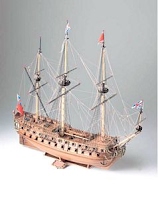 |
| HMS Resolution | 18th century British cutter Making an appearance in the early 17 hundreds, the cutter was rigged with a single mast carrying a large spanker with a gaff and a boom jibs and flying jibs and, one or more square stern-sheets. Details :Scale 1:50 Height 680 mm Length. 730 mm | 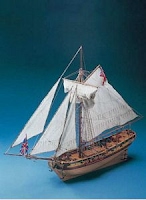 |
| HMS Unicorn | British frigate, 18th century An elegant frigate, designed for the British Fleet by Chapman at the end of the 18th century. Like the original, our model is armed with 24 guns on the open fighting deck and 8 guns below, all complete with gun mountings and wheels. The sleek and tapered line of the hull and the impressive masts make this an extremely striking and beautiful ship. The box contains a variety of precious woods all, as usual, “pre-cut”. The double planking construction permits the gun hatches to be opened by our patented procedure . Details :Scale 1:75 Height 730 mm Length. 840 mm |  |
| HMS Victory | First rate British ship, 1805 The flagship H.M.S. VICTORY is famous because of one of the most celebrated naval battles of modern times. Bought off Cape Trafalgar on 21 October 1805 between the British fleet commanded by Admiral Nelson and the Franco-Spanish fleet. Accurately restored in its equipment and the original colours the VICTORY is now a museum moored in the dry-dock at Portsmouth. Our reproduction is based on a more correct positioning of the deck superstructures and the external details and the masts taken from the original British plans. Complete new graphics and a new detailed instruction book in four languages make this a model which can be built by modellers who are not particularly expert Details :Scale 1:98 Height 715 mm Length. 1035 mm | 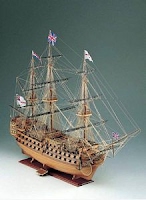 |
| Endeavour | British brig, 1768 This was the first exploration vessel of which we have reasonably accurate data today. When the ENDEAVOUR set sail from Plymouth - on 26 August 1768 under the command of the famous captain James Cook, there were 94 people aboard, including officers, scientists crew and men-servants. Before its purchase by the British Navy the ENDEAVOUR had carried coal from England to Scandinavia under the name Earl of Pembroke. The Admiralty refitted out the ship for scientific exploration: the masts were replaced, the hull was relined and a large number of guns were installed. The box contains everything necessary to construct the model Apart from Glues , Paint, and Tools . Details :Scale 1:50 Height 650 mm Length. 750 mm |  |
| HMS Victory Centre Section | Cross section at main mast A completely updated cross section of the H.M.S. VICTORY Enables us to reproduce the internal details much more realistically, in particular, the masts. The model is completed by highly realistic accessories such as casks, barrels, buckets and flag. Details :Scale 1:98 Height 715 mm Length. 325 mm | 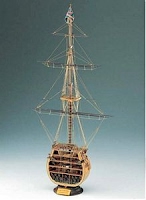 |





